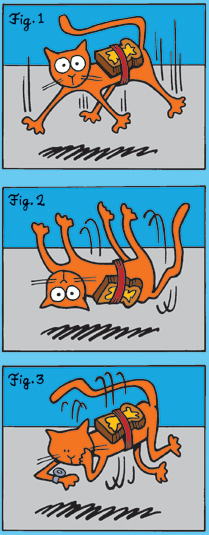Buttered cat paradox

The buttered cat paradox is a paradox based on the tongue-in-cheek combination of two adages:
- Cats always land on their feet.
- Buttered toast always lands buttered side down.
The paradox arises when one considers what would happen if one attached a piece of buttered toast (butter side up) to the back of a cat, then dropped the cat from a large height. The buttered cat paradox, submitted by artist John Frazee of Kingston, New York, won a 1993 OMNI magazine competition about paradoxes.[1]
Thought experiments
[edit]Some people jokingly maintain that the experiment will produce an anti-gravity effect. They propose that as the cat falls towards the ground, it will slow down and start to rotate, eventually reaching a steady state of hovering a short distance from the ground while rotating at high speed as both the buttered side of the toast and the cat’s feet attempt to land on the ground.[2] In June 2003, Kimberly Miner won a Student Academy Award for her film Perpetual Motion.[3] Miner based her film on a paper written by a high-school friend that explored the potential implications of the cat and buttered toast idea.[4][5]
In humor
[edit]The faux paradox has captured the imagination of science-oriented humorists. Testing the theory is the main theme in an episode of the comic book strip Jack B. Quick, the title character seeks to test this theory, leading to the cat hovering above the ground, with the cat's wagging tail providing propulsion. The March 31, 2005, strip of the webcomic Bunny also explored the idea in the guise of a plan for a "Perpetual Motion MoggieToast 5k Power Generator", based on Sod's Law.[6] In Science Askew, Donald E. Simanek comments on this phenomenon.[7]
The idea appeared on the British panel game QI, where the idea was discussed. As well as talking about the idea, they also brought up other questions regarding the paradox. These included "Would it still work if you used margarine?", "Would it still work if you used I Can't Believe It's Not Butter?", and "What if the toast was covered in something that was not butter, but the cat thought it was butter?", the idea being that it would act like a placebo.[8]
Cat righting reflex
[edit]In reality, cats do possess the ability to turn themselves right side up in mid-air if they should fall upside-down, known as the cat righting reflex.
See also
[edit]- [[Archivo:
- REDIRECCIÓN Plantilla:Iconos|20px|Ver el portal sobre Logic]] Portal:Logic. Contenido relacionado con Logic.
References
[edit]- ^ Morris, Scot (July, 1993). "I have a theory..." Omni. 15 (9): 96.
{{cite journal}}: Check date values in:|date=(help) - ^ UoWaikato newsletter
- ^ Available at http://www.kminer.net/2011/07/perpetual-motion/
- ^ PG Klein. University of Leeds. Perpetual Motion.
- ^ Oscar Nominated Animated Shorts 2003
- ^ Feline cunning and sods law
- ^ Simanek, Donald E.; Holden, John C. (2002). Science askew: a light-hearted look at the scientific world. CRC Press. p. 201. ISBN 9780750307147. Retrieved 30 June 2010.
- ^ Lua error in package.lua at line 80: module 'Module:Citation/CS1/Suggestions' not found.
External links
[edit]- Frazee Fine Arts Website of Teresa and John Frazee.
- "Feedback". New Scientist (2056). 16 November 1996.
- The Usenet Oracle where this joke appeared in 1992.
- Loopholes for the paradox
be-x-old:Парадокс ката з маслам it:Paradosso del gatto imburrato lv:Sviestmaizes-kaķa paradokss pt:Paradoxo do gato e pão com manteiga tr:Tereyağlı kedi paradoksu
